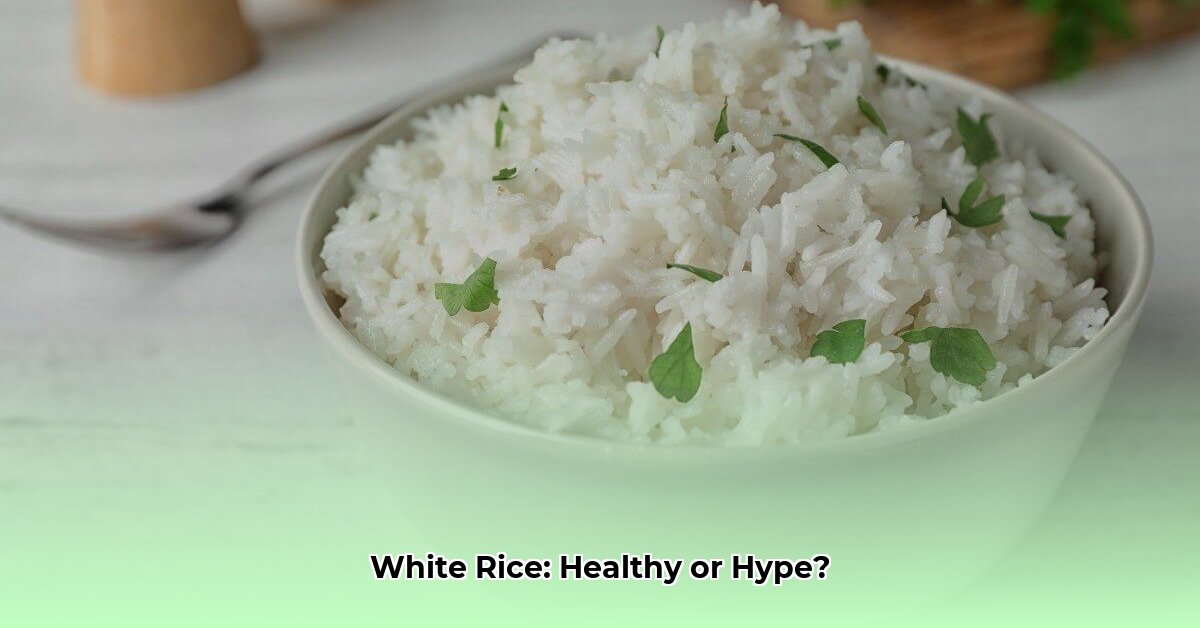White rice – a staple in countless cuisines worldwide. But amidst its popularity, a question lingers: is it truly healthy? This article delves into the nutritional nuances of white rice, comparing it to brown rice, debunking common myths, and offering practical tips for incorporating it into a balanced diet.
White vs. Brown: A Nutritional Showdown
Let’s compare white rice to its whole-grain counterpart, brown rice. Brown rice retains the bran and germ, nutrient-rich layers removed during the milling process that creates white rice. This difference significantly impacts their nutritional profiles.
| Feature | White Rice | Brown Rice |
|---|---|---|
| Fiber (g) | <1 | ~3.5 |
| Magnesium (mg) | ~19 | ~84 |
| B Vitamins | Lower | Higher |
| Glycemic Index | Higher | Lower |
| Arsenic Levels | Potentially higher, rinsing helps | Potentially higher, rinsing helps |
| Digestibility | Easier | Can be tougher |
Decoding White Rice: Nutrients and More
White rice primarily consists of carbohydrates, providing a readily available energy source. It’s low in fat and offers a small amount of protein. While enrichment adds back some vitamins and minerals lost during processing, it doesn’t fully replicate the nutritional richness of brown rice. For example, brown rice boasts significantly more magnesium, a mineral crucial for muscle function, blood sugar control, and potentially bone health (ongoing research continues to explore this).
White Rice: Benefits and Risks
White rice offers several advantages:
- Easy Digestion: It’s gentle on the stomach, particularly beneficial for those with digestive sensitivities.
- Quick Energy: Provides readily available carbohydrates for a rapid energy boost.
- Fortified Options: Enriched versions offer added iron and B vitamins.
- Gluten-Free: Suitable for individuals with celiac disease or gluten intolerance.
- Affordability: Generally less expensive than other rice varieties.
However, there are potential downsides:
- Blood Sugar Spikes: Its higher glycemic index can cause rapid blood sugar increases, potentially impacting long-term metabolic health (research is ongoing).
- Lower Nutrient Content: Compared to brown rice, it lacks significant fiber, magnesium, and various antioxidants. While the impact of these differences on long-term health is still being investigated, some studies suggest a possible link between white rice consumption and metabolic syndrome.
- Arsenic Content: Rice can absorb arsenic from the environment. Rinsing before cooking helps reduce levels, but doesn’t eliminate the risk entirely. Choosing rice from regions known for lower arsenic levels, such as California, might be beneficial.
- Potential for Weight Gain: Overconsumption, particularly without accompanying nutrient-rich foods, could contribute to weight gain.
Optimizing White Rice for Health
Here’s how to make white rice a healthier part of your diet:
- Mindful Portions: Practice portion control to manage calorie intake.
- Nutrient Boosters: Combine white rice with fiber-rich vegetables, lean proteins (fish, chicken, beans, lentils), and healthy fats (avocado, nuts, seeds). This creates a more balanced, nutritious, and satisfying meal.
- Choose Enriched: Opt for enriched versions to maximize micronutrient intake.
- Rinse Thoroughly: Reduce arsenic levels by rinsing rice before cooking and using excess water.
- Explore Variety: Alternate with other whole grains like quinoa, barley, farro, and wild rice to diversify your nutrient intake and explore different flavors and textures. Wild rice, while technically a seed, offers exceptional nutritional value, packed with fiber and antioxidants.
- Cooling and Resistant Starch: Cooling cooked white rice increases resistant starch, a type of fiber that may offer gut health benefits and potentially lower the glycemic index. This area of research is still developing, but initial findings suggest promising health implications.
White Rice and Specific Diets
For those managing diabetes or other conditions requiring blood sugar control, portion control and pairing white rice with fiber-rich foods and lean protein is crucial. Consult a registered dietitian or certified diabetes educator for personalized guidance.
Beyond Nutrition: Culture and Sustainability
Rice plays a vital role in global cuisines and food security. However, its cultivation can have a significant environmental impact. Exploring sustainable rice farming practices and supporting brands committed to environmental responsibility can help mitigate these concerns. Ongoing research is investigating more sustainable methods for rice production.
Debunking Myths
- Myth: White rice has zero nutritional value. Fact: While less nutrient-dense than brown rice, enriched white rice still provides essential nutrients.
- Myth: White rice invariably leads to weight gain. Fact: Weight gain is more likely related to overall calorie intake and dietary patterns, not solely white rice consumption.
Conclusion: Finding Balance with White Rice
Is white rice healthy? The answer is nuanced. While brown rice generally offers greater nutritional value, white rice can be part of a balanced diet, especially when consumed mindfully and paired strategically with other nutritious foods. Consider your individual needs, preferences, and overall dietary patterns to make informed choices about incorporating white rice into your meals. By understanding its nutritional profile and embracing a balanced approach, you can enjoy this versatile grain without compromising your health.
- Plastic Bento Boxes Make Meal Prep and Cleanup Effortless - December 8, 2025
- Shop Bento Lunch Boxes on Sale Nearby Now - December 7, 2025
- Shop Bento Box for Sale To Find Your Ideal Lunch Container - December 6, 2025










